301061 Construction Work Safety: Analyzing Workplace Accidents
VerifiedAdded on 2023/06/11
|18
|3474
|360
Case Study
AI Summary
This case study examines a construction accident where a worker fell due to improper safety belt usage, highlighting the costs and consequences of such incidents. It reviews literature on accident costs, categorizing them into direct and indirect costs, and outlines a framework for assessing the severity of accidents and their economic impact. The analysis includes production disturbance costs, human capital costs, medical costs, administrative costs, transfer costs, and other unclassified costs, providing a comprehensive overview of the financial burden associated with construction site accidents. The study emphasizes the importance of investing in safety programs to reduce accidents and improve overall productivity and worker well-being. Desklib offers additional resources and solved assignments for students studying construction safety and related topics.
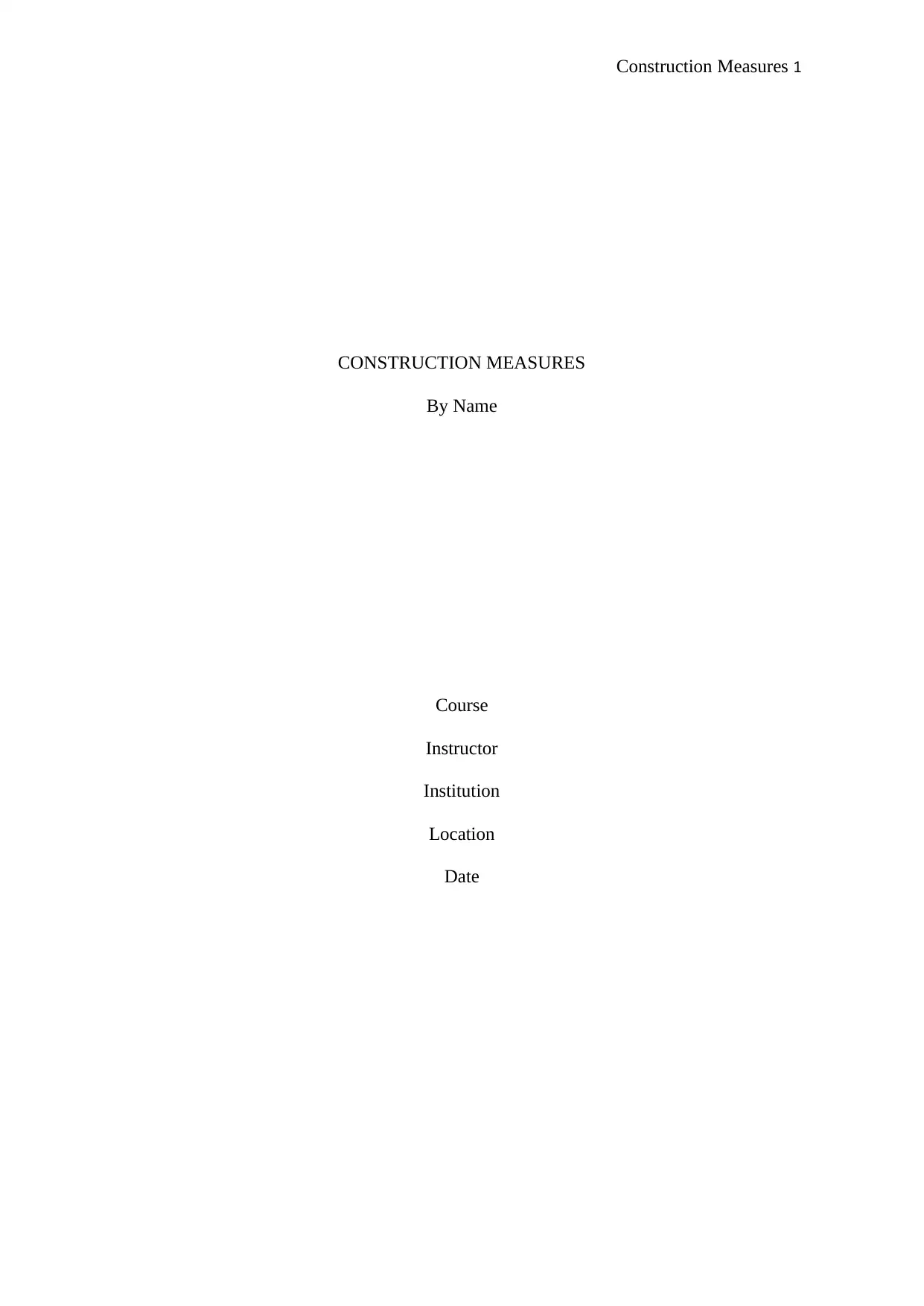
Construction Measures 1
CONSTRUCTION MEASURES
By Name
Course
Instructor
Institution
Location
Date
CONSTRUCTION MEASURES
By Name
Course
Instructor
Institution
Location
Date
Paraphrase This Document
Need a fresh take? Get an instant paraphrase of this document with our AI Paraphraser
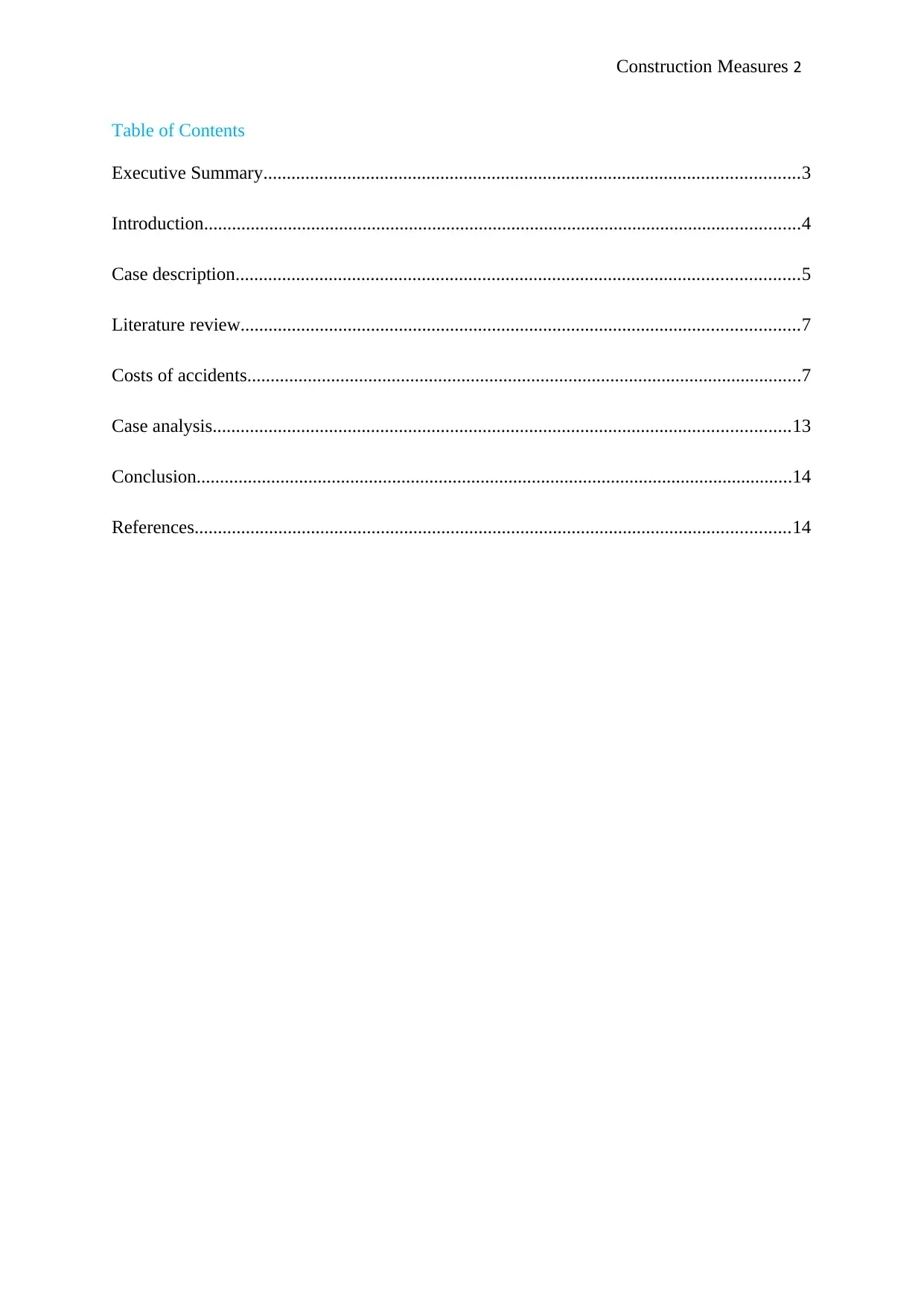
Construction Measures 2
Table of Contents
Executive Summary...................................................................................................................3
Introduction................................................................................................................................4
Case description.........................................................................................................................5
Literature review........................................................................................................................7
Costs of accidents.......................................................................................................................7
Case analysis............................................................................................................................13
Conclusion................................................................................................................................14
References................................................................................................................................14
Table of Contents
Executive Summary...................................................................................................................3
Introduction................................................................................................................................4
Case description.........................................................................................................................5
Literature review........................................................................................................................7
Costs of accidents.......................................................................................................................7
Case analysis............................................................................................................................13
Conclusion................................................................................................................................14
References................................................................................................................................14
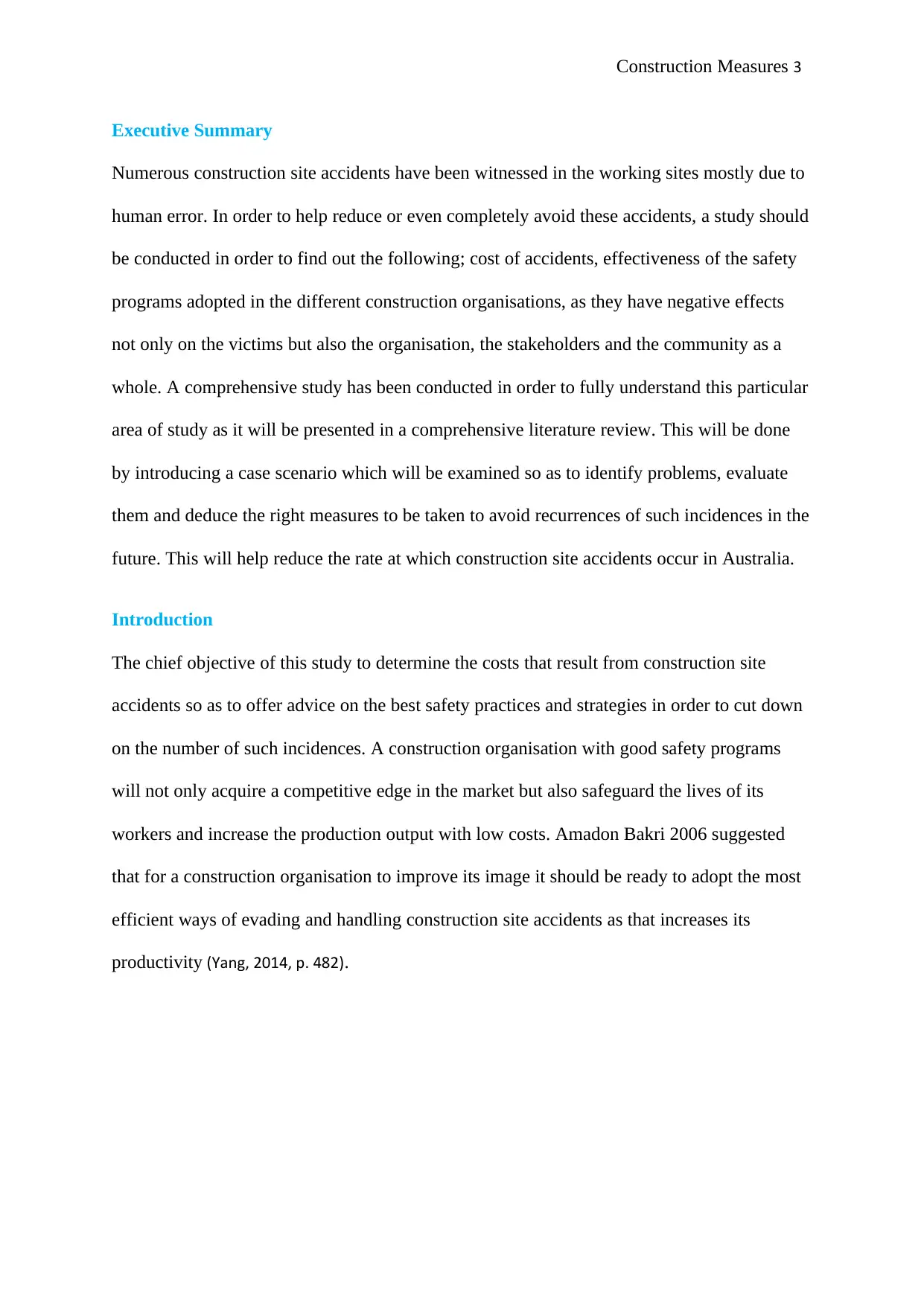
Construction Measures 3
Executive Summary
Numerous construction site accidents have been witnessed in the working sites mostly due to
human error. In order to help reduce or even completely avoid these accidents, a study should
be conducted in order to find out the following; cost of accidents, effectiveness of the safety
programs adopted in the different construction organisations, as they have negative effects
not only on the victims but also the organisation, the stakeholders and the community as a
whole. A comprehensive study has been conducted in order to fully understand this particular
area of study as it will be presented in a comprehensive literature review. This will be done
by introducing a case scenario which will be examined so as to identify problems, evaluate
them and deduce the right measures to be taken to avoid recurrences of such incidences in the
future. This will help reduce the rate at which construction site accidents occur in Australia.
Introduction
The chief objective of this study to determine the costs that result from construction site
accidents so as to offer advice on the best safety practices and strategies in order to cut down
on the number of such incidences. A construction organisation with good safety programs
will not only acquire a competitive edge in the market but also safeguard the lives of its
workers and increase the production output with low costs. Amadon Bakri 2006 suggested
that for a construction organisation to improve its image it should be ready to adopt the most
efficient ways of evading and handling construction site accidents as that increases its
productivity (Yang, 2014, p. 482).
Executive Summary
Numerous construction site accidents have been witnessed in the working sites mostly due to
human error. In order to help reduce or even completely avoid these accidents, a study should
be conducted in order to find out the following; cost of accidents, effectiveness of the safety
programs adopted in the different construction organisations, as they have negative effects
not only on the victims but also the organisation, the stakeholders and the community as a
whole. A comprehensive study has been conducted in order to fully understand this particular
area of study as it will be presented in a comprehensive literature review. This will be done
by introducing a case scenario which will be examined so as to identify problems, evaluate
them and deduce the right measures to be taken to avoid recurrences of such incidences in the
future. This will help reduce the rate at which construction site accidents occur in Australia.
Introduction
The chief objective of this study to determine the costs that result from construction site
accidents so as to offer advice on the best safety practices and strategies in order to cut down
on the number of such incidences. A construction organisation with good safety programs
will not only acquire a competitive edge in the market but also safeguard the lives of its
workers and increase the production output with low costs. Amadon Bakri 2006 suggested
that for a construction organisation to improve its image it should be ready to adopt the most
efficient ways of evading and handling construction site accidents as that increases its
productivity (Yang, 2014, p. 482).
⊘ This is a preview!⊘
Do you want full access?
Subscribe today to unlock all pages.

Trusted by 1+ million students worldwide
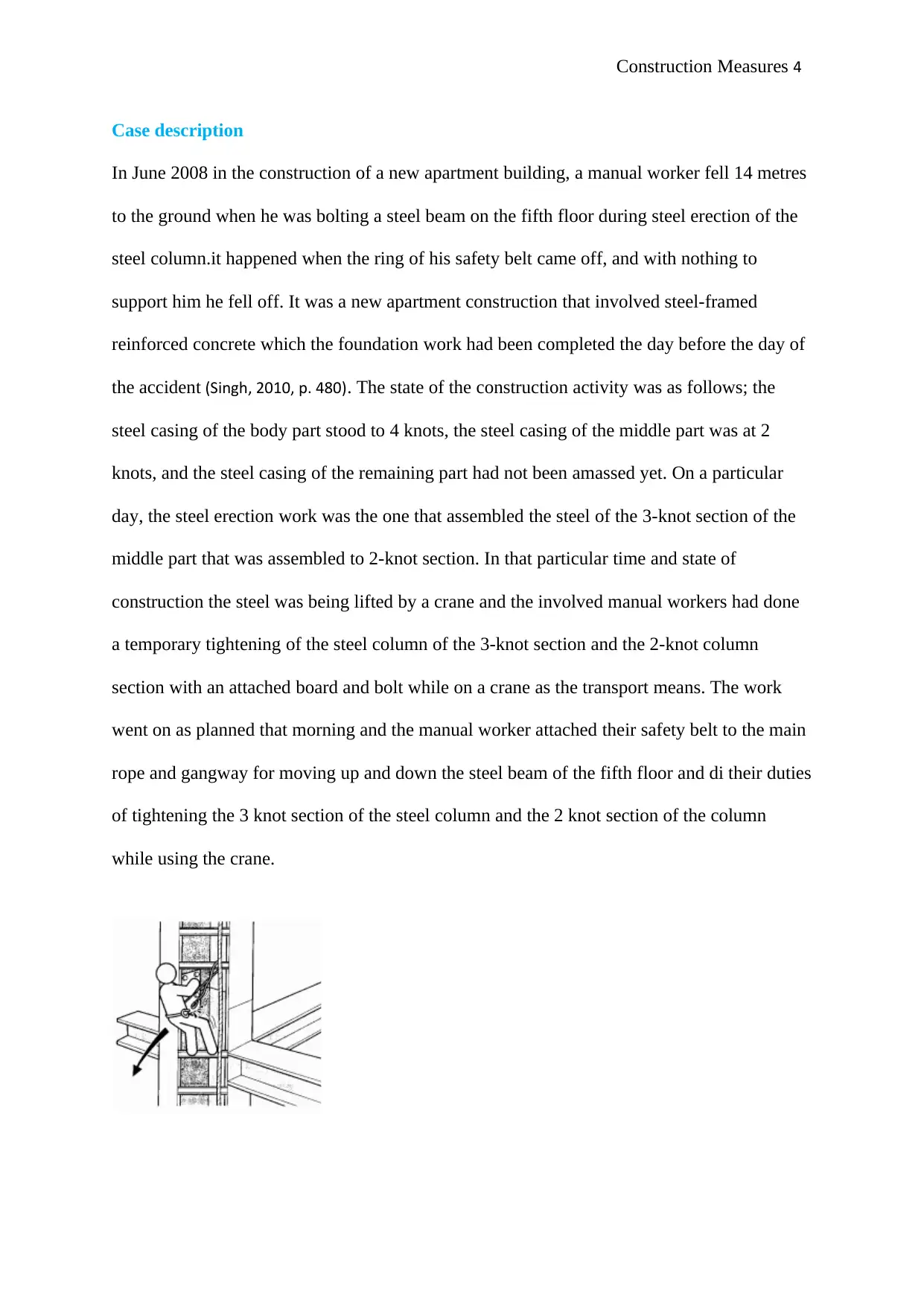
Construction Measures 4
Case description
In June 2008 in the construction of a new apartment building, a manual worker fell 14 metres
to the ground when he was bolting a steel beam on the fifth floor during steel erection of the
steel column.it happened when the ring of his safety belt came off, and with nothing to
support him he fell off. It was a new apartment construction that involved steel-framed
reinforced concrete which the foundation work had been completed the day before the day of
the accident (Singh, 2010, p. 480). The state of the construction activity was as follows; the
steel casing of the body part stood to 4 knots, the steel casing of the middle part was at 2
knots, and the steel casing of the remaining part had not been amassed yet. On a particular
day, the steel erection work was the one that assembled the steel of the 3-knot section of the
middle part that was assembled to 2-knot section. In that particular time and state of
construction the steel was being lifted by a crane and the involved manual workers had done
a temporary tightening of the steel column of the 3-knot section and the 2-knot column
section with an attached board and bolt while on a crane as the transport means. The work
went on as planned that morning and the manual worker attached their safety belt to the main
rope and gangway for moving up and down the steel beam of the fifth floor and di their duties
of tightening the 3 knot section of the steel column and the 2 knot section of the column
while using the crane.
Case description
In June 2008 in the construction of a new apartment building, a manual worker fell 14 metres
to the ground when he was bolting a steel beam on the fifth floor during steel erection of the
steel column.it happened when the ring of his safety belt came off, and with nothing to
support him he fell off. It was a new apartment construction that involved steel-framed
reinforced concrete which the foundation work had been completed the day before the day of
the accident (Singh, 2010, p. 480). The state of the construction activity was as follows; the
steel casing of the body part stood to 4 knots, the steel casing of the middle part was at 2
knots, and the steel casing of the remaining part had not been amassed yet. On a particular
day, the steel erection work was the one that assembled the steel of the 3-knot section of the
middle part that was assembled to 2-knot section. In that particular time and state of
construction the steel was being lifted by a crane and the involved manual workers had done
a temporary tightening of the steel column of the 3-knot section and the 2-knot column
section with an attached board and bolt while on a crane as the transport means. The work
went on as planned that morning and the manual worker attached their safety belt to the main
rope and gangway for moving up and down the steel beam of the fifth floor and di their duties
of tightening the 3 knot section of the steel column and the 2 knot section of the column
while using the crane.
Paraphrase This Document
Need a fresh take? Get an instant paraphrase of this document with our AI Paraphraser
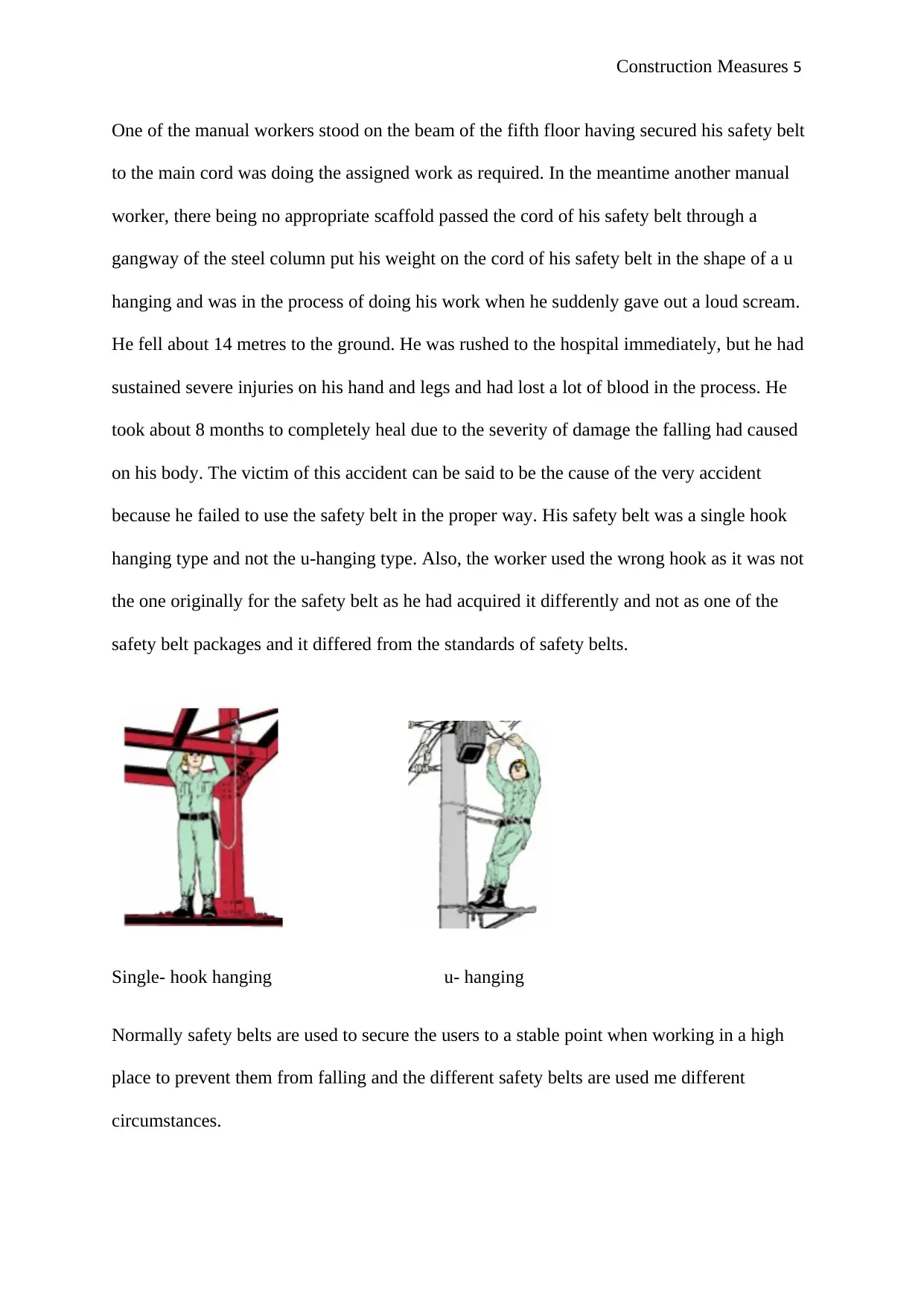
Construction Measures 5
One of the manual workers stood on the beam of the fifth floor having secured his safety belt
to the main cord was doing the assigned work as required. In the meantime another manual
worker, there being no appropriate scaffold passed the cord of his safety belt through a
gangway of the steel column put his weight on the cord of his safety belt in the shape of a u
hanging and was in the process of doing his work when he suddenly gave out a loud scream.
He fell about 14 metres to the ground. He was rushed to the hospital immediately, but he had
sustained severe injuries on his hand and legs and had lost a lot of blood in the process. He
took about 8 months to completely heal due to the severity of damage the falling had caused
on his body. The victim of this accident can be said to be the cause of the very accident
because he failed to use the safety belt in the proper way. His safety belt was a single hook
hanging type and not the u-hanging type. Also, the worker used the wrong hook as it was not
the one originally for the safety belt as he had acquired it differently and not as one of the
safety belt packages and it differed from the standards of safety belts.
Single- hook hanging u- hanging
Normally safety belts are used to secure the users to a stable point when working in a high
place to prevent them from falling and the different safety belts are used me different
circumstances.
One of the manual workers stood on the beam of the fifth floor having secured his safety belt
to the main cord was doing the assigned work as required. In the meantime another manual
worker, there being no appropriate scaffold passed the cord of his safety belt through a
gangway of the steel column put his weight on the cord of his safety belt in the shape of a u
hanging and was in the process of doing his work when he suddenly gave out a loud scream.
He fell about 14 metres to the ground. He was rushed to the hospital immediately, but he had
sustained severe injuries on his hand and legs and had lost a lot of blood in the process. He
took about 8 months to completely heal due to the severity of damage the falling had caused
on his body. The victim of this accident can be said to be the cause of the very accident
because he failed to use the safety belt in the proper way. His safety belt was a single hook
hanging type and not the u-hanging type. Also, the worker used the wrong hook as it was not
the one originally for the safety belt as he had acquired it differently and not as one of the
safety belt packages and it differed from the standards of safety belts.
Single- hook hanging u- hanging
Normally safety belts are used to secure the users to a stable point when working in a high
place to prevent them from falling and the different safety belts are used me different
circumstances.
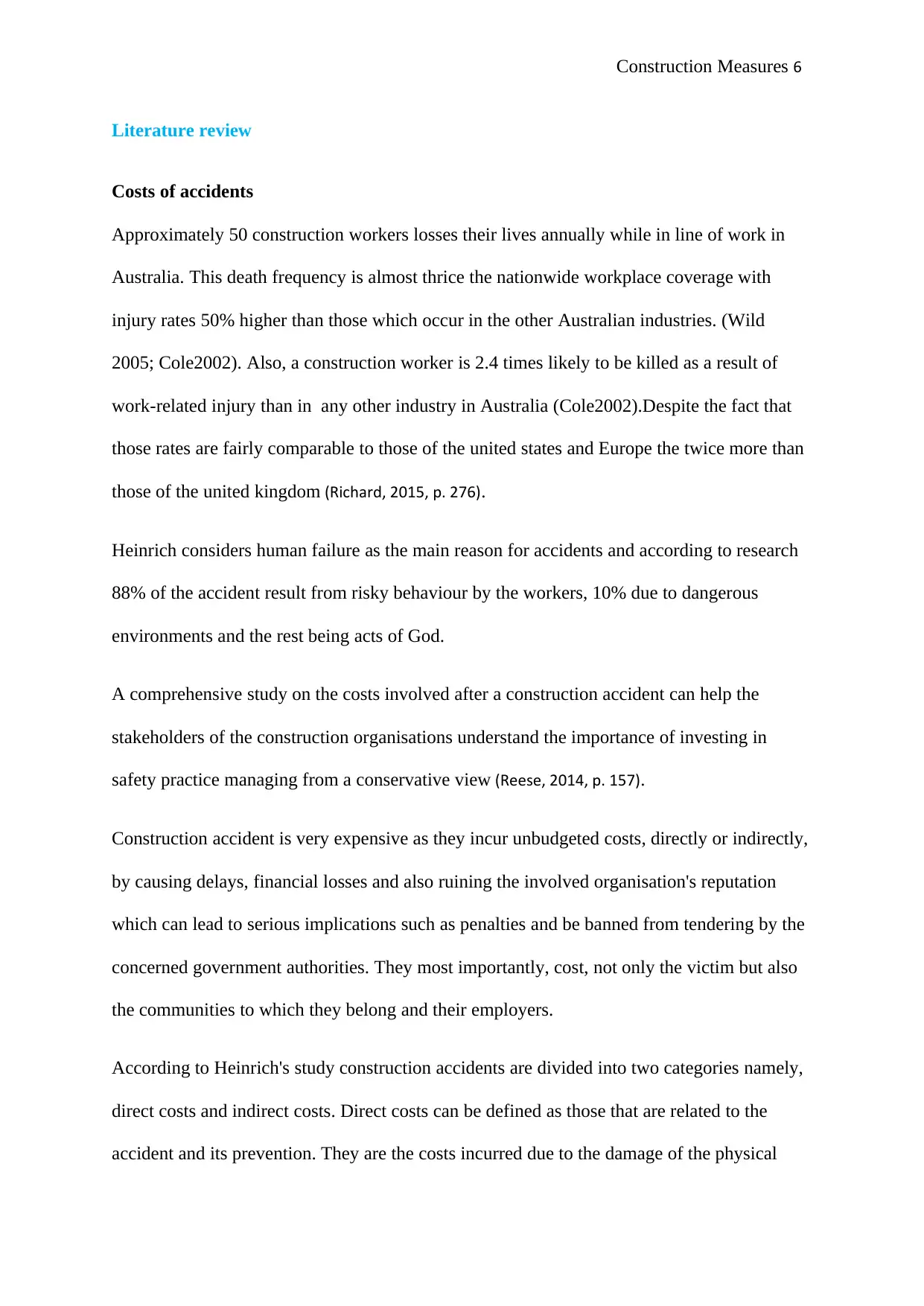
Construction Measures 6
Literature review
Costs of accidents
Approximately 50 construction workers losses their lives annually while in line of work in
Australia. This death frequency is almost thrice the nationwide workplace coverage with
injury rates 50% higher than those which occur in the other Australian industries. (Wild
2005; Cole2002). Also, a construction worker is 2.4 times likely to be killed as a result of
work-related injury than in any other industry in Australia (Cole2002).Despite the fact that
those rates are fairly comparable to those of the united states and Europe the twice more than
those of the united kingdom (Richard, 2015, p. 276).
Heinrich considers human failure as the main reason for accidents and according to research
88% of the accident result from risky behaviour by the workers, 10% due to dangerous
environments and the rest being acts of God.
A comprehensive study on the costs involved after a construction accident can help the
stakeholders of the construction organisations understand the importance of investing in
safety practice managing from a conservative view (Reese, 2014, p. 157).
Construction accident is very expensive as they incur unbudgeted costs, directly or indirectly,
by causing delays, financial losses and also ruining the involved organisation's reputation
which can lead to serious implications such as penalties and be banned from tendering by the
concerned government authorities. They most importantly, cost, not only the victim but also
the communities to which they belong and their employers.
According to Heinrich's study construction accidents are divided into two categories namely,
direct costs and indirect costs. Direct costs can be defined as those that are related to the
accident and its prevention. They are the costs incurred due to the damage of the physical
Literature review
Costs of accidents
Approximately 50 construction workers losses their lives annually while in line of work in
Australia. This death frequency is almost thrice the nationwide workplace coverage with
injury rates 50% higher than those which occur in the other Australian industries. (Wild
2005; Cole2002). Also, a construction worker is 2.4 times likely to be killed as a result of
work-related injury than in any other industry in Australia (Cole2002).Despite the fact that
those rates are fairly comparable to those of the united states and Europe the twice more than
those of the united kingdom (Richard, 2015, p. 276).
Heinrich considers human failure as the main reason for accidents and according to research
88% of the accident result from risky behaviour by the workers, 10% due to dangerous
environments and the rest being acts of God.
A comprehensive study on the costs involved after a construction accident can help the
stakeholders of the construction organisations understand the importance of investing in
safety practice managing from a conservative view (Reese, 2014, p. 157).
Construction accident is very expensive as they incur unbudgeted costs, directly or indirectly,
by causing delays, financial losses and also ruining the involved organisation's reputation
which can lead to serious implications such as penalties and be banned from tendering by the
concerned government authorities. They most importantly, cost, not only the victim but also
the communities to which they belong and their employers.
According to Heinrich's study construction accidents are divided into two categories namely,
direct costs and indirect costs. Direct costs can be defined as those that are related to the
accident and its prevention. They are the costs incurred due to the damage of the physical
⊘ This is a preview!⊘
Do you want full access?
Subscribe today to unlock all pages.

Trusted by 1+ million students worldwide
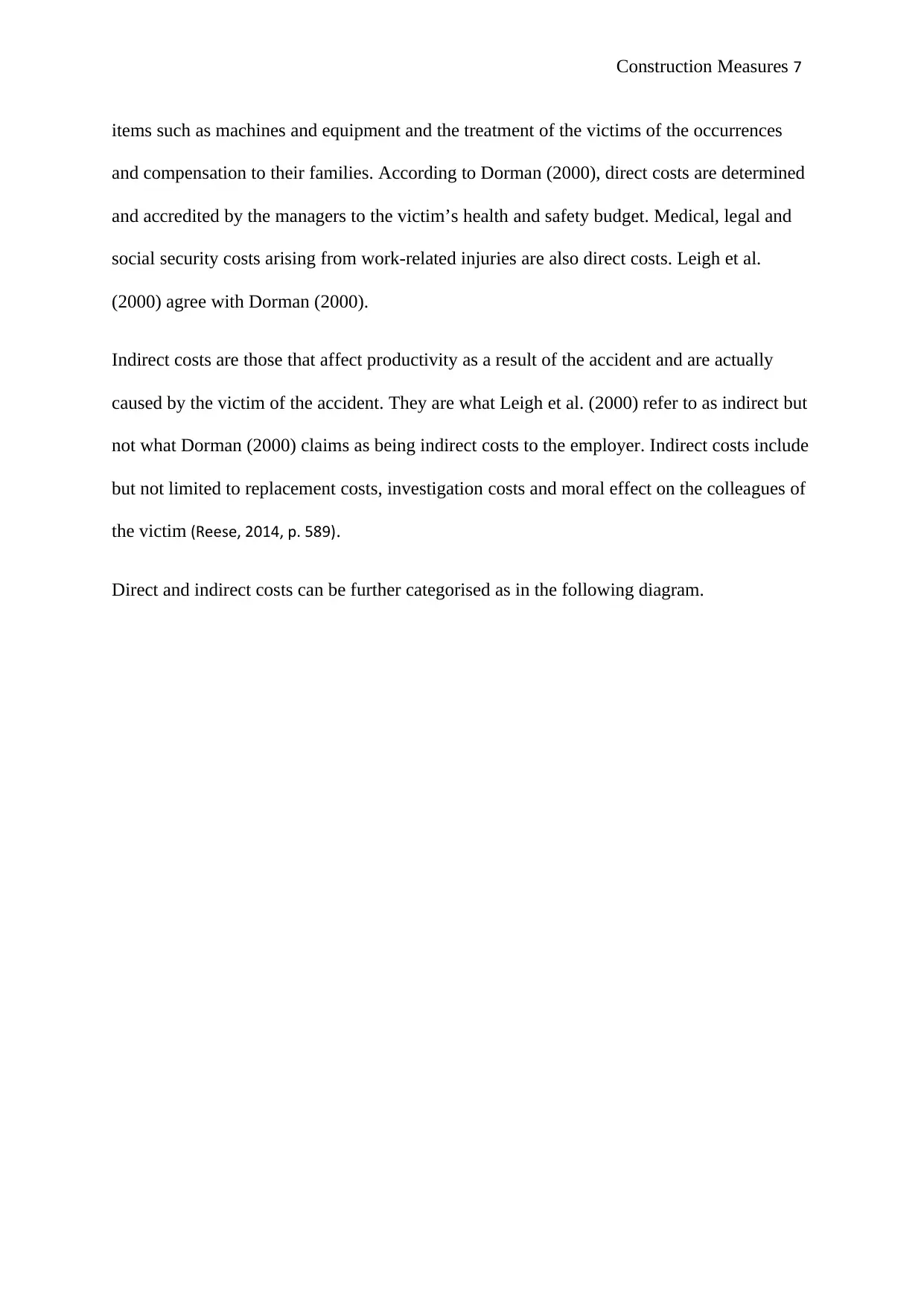
Construction Measures 7
items such as machines and equipment and the treatment of the victims of the occurrences
and compensation to their families. According to Dorman (2000), direct costs are determined
and accredited by the managers to the victim’s health and safety budget. Medical, legal and
social security costs arising from work-related injuries are also direct costs. Leigh et al.
(2000) agree with Dorman (2000).
Indirect costs are those that affect productivity as a result of the accident and are actually
caused by the victim of the accident. They are what Leigh et al. (2000) refer to as indirect but
not what Dorman (2000) claims as being indirect costs to the employer. Indirect costs include
but not limited to replacement costs, investigation costs and moral effect on the colleagues of
the victim (Reese, 2014, p. 589).
Direct and indirect costs can be further categorised as in the following diagram.
items such as machines and equipment and the treatment of the victims of the occurrences
and compensation to their families. According to Dorman (2000), direct costs are determined
and accredited by the managers to the victim’s health and safety budget. Medical, legal and
social security costs arising from work-related injuries are also direct costs. Leigh et al.
(2000) agree with Dorman (2000).
Indirect costs are those that affect productivity as a result of the accident and are actually
caused by the victim of the accident. They are what Leigh et al. (2000) refer to as indirect but
not what Dorman (2000) claims as being indirect costs to the employer. Indirect costs include
but not limited to replacement costs, investigation costs and moral effect on the colleagues of
the victim (Reese, 2014, p. 589).
Direct and indirect costs can be further categorised as in the following diagram.
Paraphrase This Document
Need a fresh take? Get an instant paraphrase of this document with our AI Paraphraser
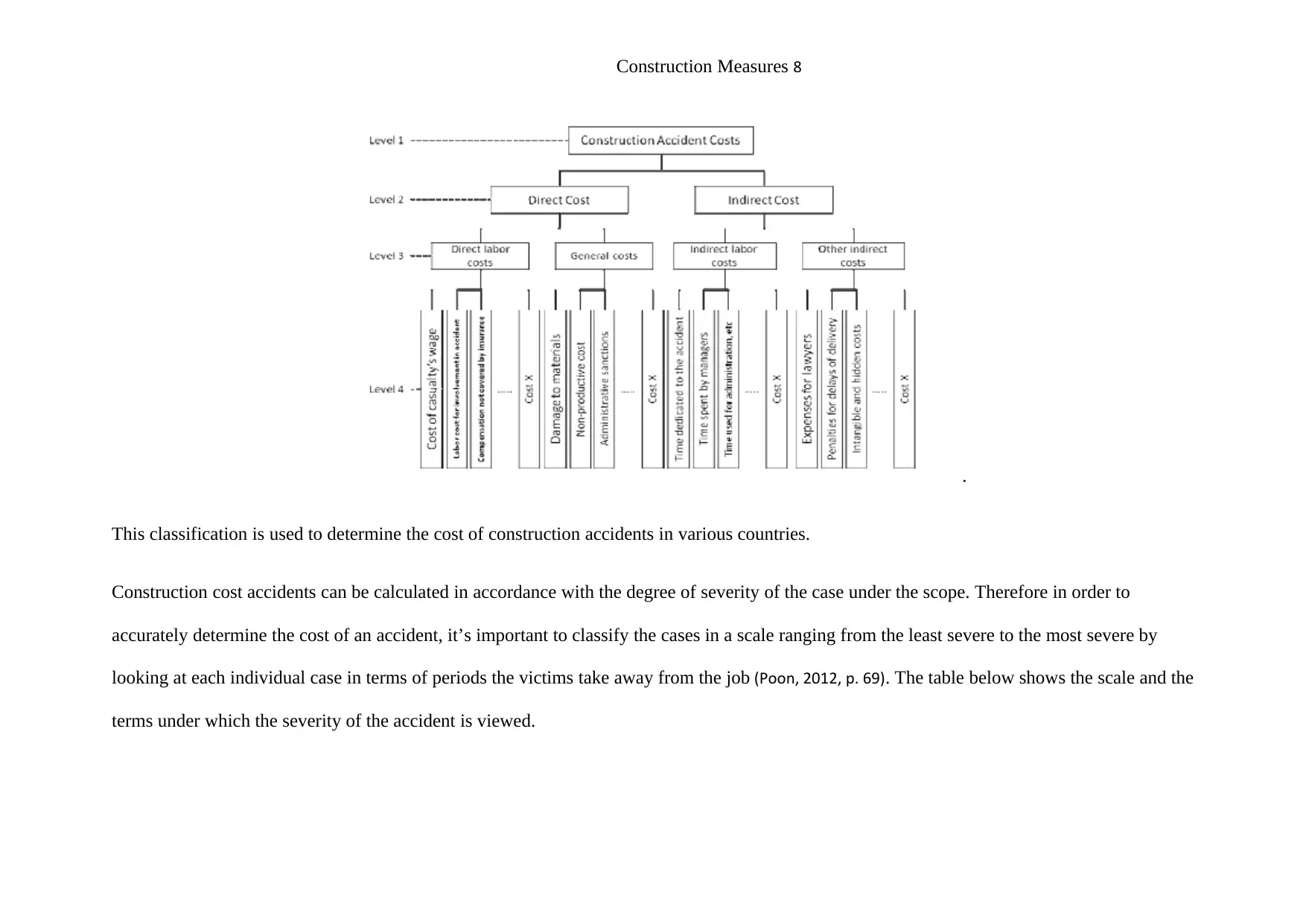
Construction Measures 8
.
This classification is used to determine the cost of construction accidents in various countries.
Construction cost accidents can be calculated in accordance with the degree of severity of the case under the scope. Therefore in order to
accurately determine the cost of an accident, it’s important to classify the cases in a scale ranging from the least severe to the most severe by
looking at each individual case in terms of periods the victims take away from the job (Poon, 2012, p. 69). The table below shows the scale and the
terms under which the severity of the accident is viewed.
.
This classification is used to determine the cost of construction accidents in various countries.
Construction cost accidents can be calculated in accordance with the degree of severity of the case under the scope. Therefore in order to
accurately determine the cost of an accident, it’s important to classify the cases in a scale ranging from the least severe to the most severe by
looking at each individual case in terms of periods the victims take away from the job (Poon, 2012, p. 69). The table below shows the scale and the
terms under which the severity of the accident is viewed.
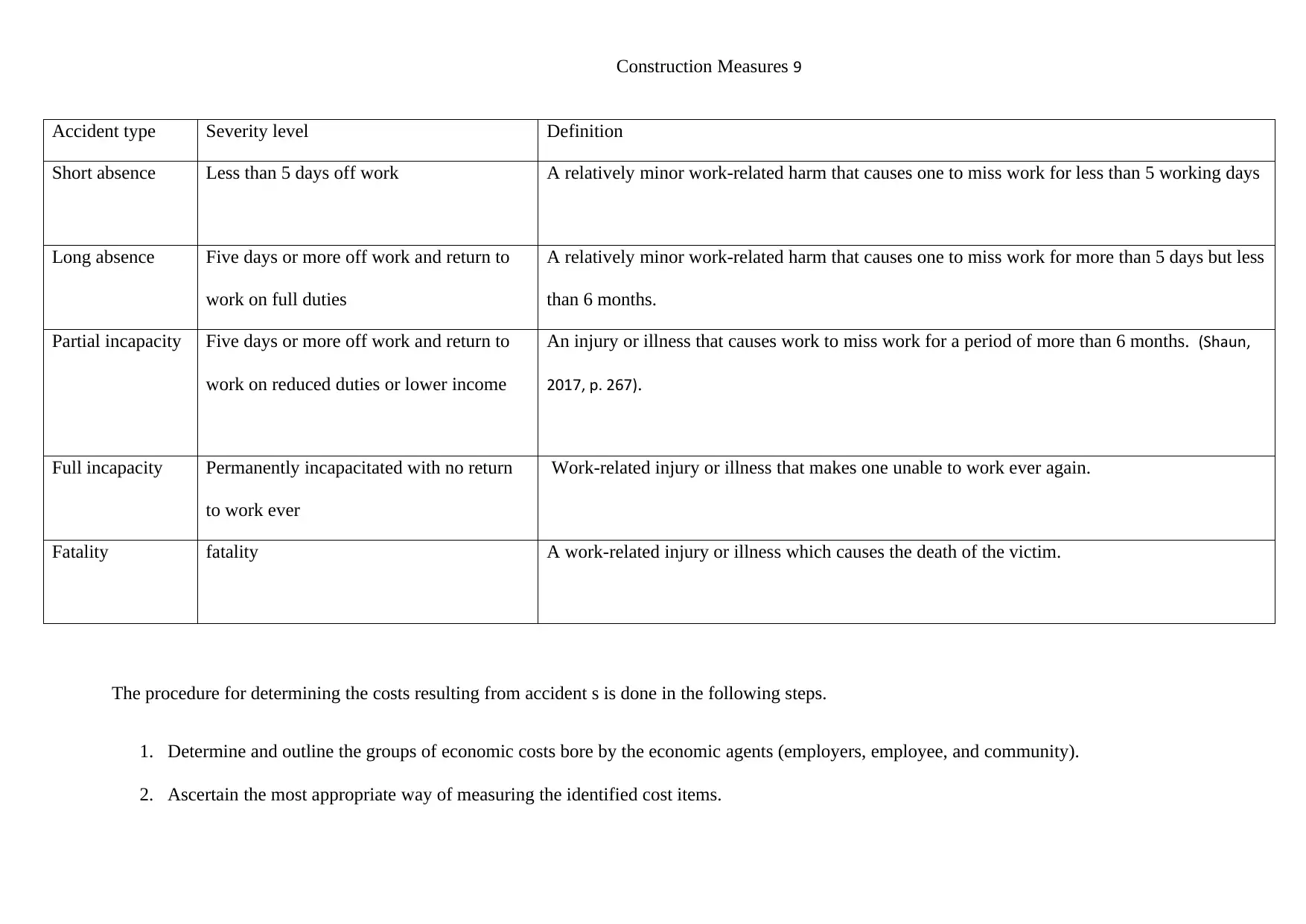
Construction Measures 9
Accident type Severity level Definition
Short absence Less than 5 days off work A relatively minor work-related harm that causes one to miss work for less than 5 working days
Long absence Five days or more off work and return to
work on full duties
A relatively minor work-related harm that causes one to miss work for more than 5 days but less
than 6 months.
Partial incapacity Five days or more off work and return to
work on reduced duties or lower income
An injury or illness that causes work to miss work for a period of more than 6 months. (Shaun,
2017, p. 267).
Full incapacity Permanently incapacitated with no return
to work ever
Work-related injury or illness that makes one unable to work ever again.
Fatality fatality A work-related injury or illness which causes the death of the victim.
The procedure for determining the costs resulting from accident s is done in the following steps.
1. Determine and outline the groups of economic costs bore by the economic agents (employers, employee, and community).
2. Ascertain the most appropriate way of measuring the identified cost items.
Accident type Severity level Definition
Short absence Less than 5 days off work A relatively minor work-related harm that causes one to miss work for less than 5 working days
Long absence Five days or more off work and return to
work on full duties
A relatively minor work-related harm that causes one to miss work for more than 5 days but less
than 6 months.
Partial incapacity Five days or more off work and return to
work on reduced duties or lower income
An injury or illness that causes work to miss work for a period of more than 6 months. (Shaun,
2017, p. 267).
Full incapacity Permanently incapacitated with no return
to work ever
Work-related injury or illness that makes one unable to work ever again.
Fatality fatality A work-related injury or illness which causes the death of the victim.
The procedure for determining the costs resulting from accident s is done in the following steps.
1. Determine and outline the groups of economic costs bore by the economic agents (employers, employee, and community).
2. Ascertain the most appropriate way of measuring the identified cost items.
⊘ This is a preview!⊘
Do you want full access?
Subscribe today to unlock all pages.

Trusted by 1+ million students worldwide
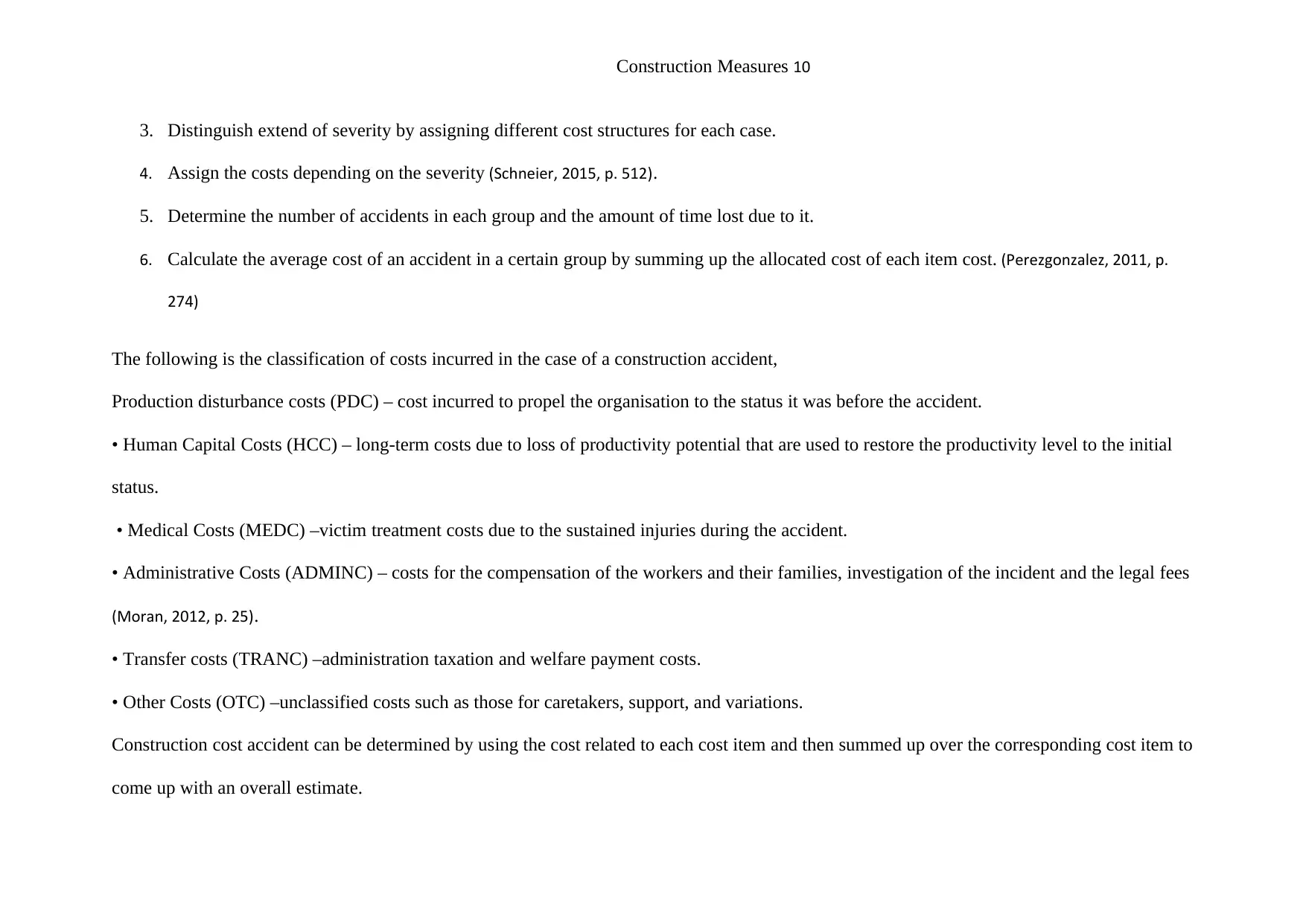
Construction Measures 10
3. Distinguish extend of severity by assigning different cost structures for each case.
4. Assign the costs depending on the severity (Schneier, 2015, p. 512).
5. Determine the number of accidents in each group and the amount of time lost due to it.
6. Calculate the average cost of an accident in a certain group by summing up the allocated cost of each item cost. (Perezgonzalez, 2011, p.
274)
The following is the classification of costs incurred in the case of a construction accident,
Production disturbance costs (PDC) – cost incurred to propel the organisation to the status it was before the accident.
• Human Capital Costs (HCC) – long-term costs due to loss of productivity potential that are used to restore the productivity level to the initial
status.
• Medical Costs (MEDC) –victim treatment costs due to the sustained injuries during the accident.
• Administrative Costs (ADMINC) – costs for the compensation of the workers and their families, investigation of the incident and the legal fees
(Moran, 2012, p. 25).
• Transfer costs (TRANC) –administration taxation and welfare payment costs.
• Other Costs (OTC) –unclassified costs such as those for caretakers, support, and variations.
Construction cost accident can be determined by using the cost related to each cost item and then summed up over the corresponding cost item to
come up with an overall estimate.
3. Distinguish extend of severity by assigning different cost structures for each case.
4. Assign the costs depending on the severity (Schneier, 2015, p. 512).
5. Determine the number of accidents in each group and the amount of time lost due to it.
6. Calculate the average cost of an accident in a certain group by summing up the allocated cost of each item cost. (Perezgonzalez, 2011, p.
274)
The following is the classification of costs incurred in the case of a construction accident,
Production disturbance costs (PDC) – cost incurred to propel the organisation to the status it was before the accident.
• Human Capital Costs (HCC) – long-term costs due to loss of productivity potential that are used to restore the productivity level to the initial
status.
• Medical Costs (MEDC) –victim treatment costs due to the sustained injuries during the accident.
• Administrative Costs (ADMINC) – costs for the compensation of the workers and their families, investigation of the incident and the legal fees
(Moran, 2012, p. 25).
• Transfer costs (TRANC) –administration taxation and welfare payment costs.
• Other Costs (OTC) –unclassified costs such as those for caretakers, support, and variations.
Construction cost accident can be determined by using the cost related to each cost item and then summed up over the corresponding cost item to
come up with an overall estimate.
Paraphrase This Document
Need a fresh take? Get an instant paraphrase of this document with our AI Paraphraser
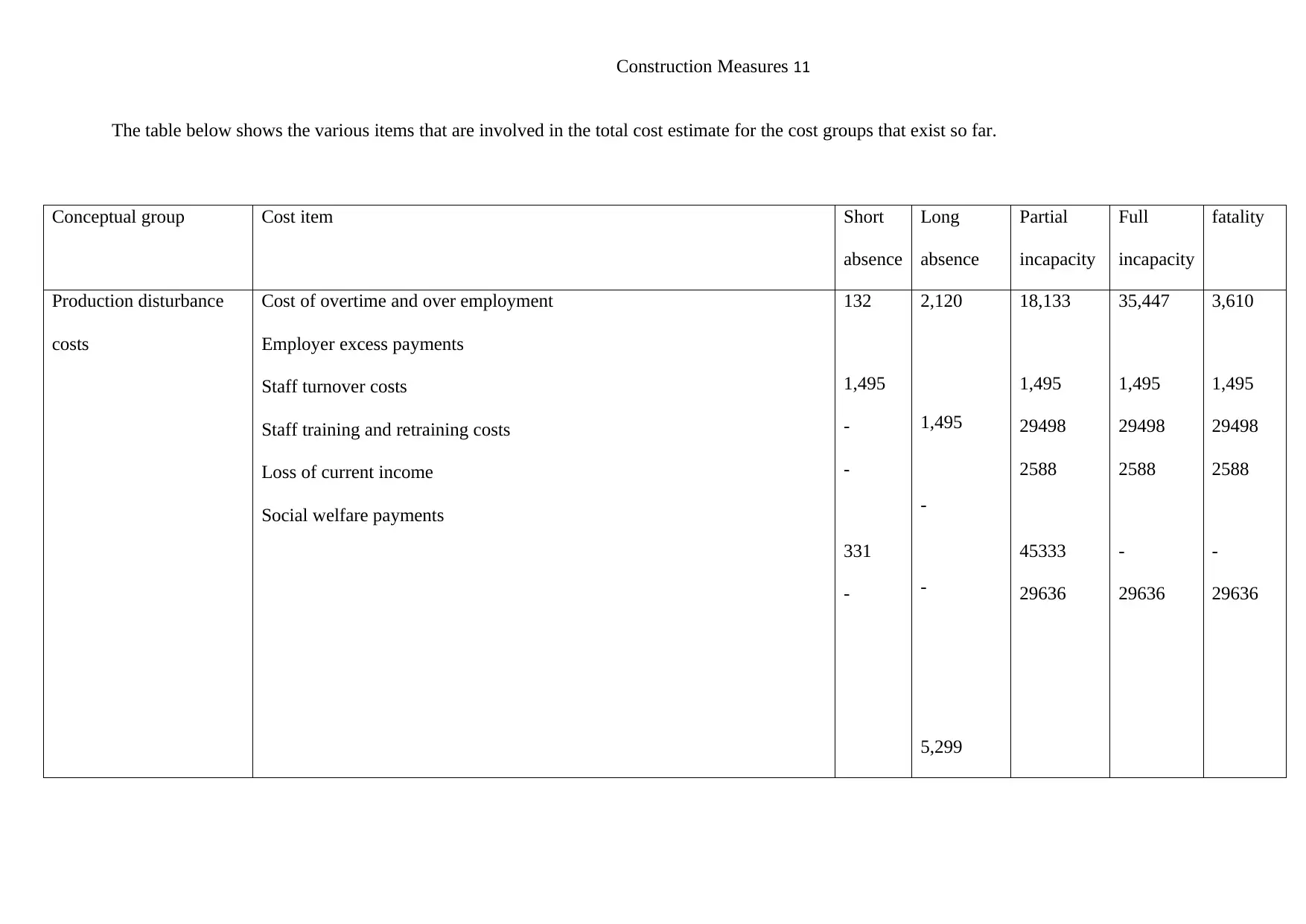
Construction Measures 11
The table below shows the various items that are involved in the total cost estimate for the cost groups that exist so far.
Conceptual group Cost item Short
absence
Long
absence
Partial
incapacity
Full
incapacity
fatality
Production disturbance
costs
Cost of overtime and over employment
Employer excess payments
Staff turnover costs
Staff training and retraining costs
Loss of current income
Social welfare payments
132
1,495
-
-
331
-
2,120
1,495
-
-
5,299
18,133
1,495
29498
2588
45333
29636
35,447
1,495
29498
2588
-
29636
3,610
1,495
29498
2588
-
29636
The table below shows the various items that are involved in the total cost estimate for the cost groups that exist so far.
Conceptual group Cost item Short
absence
Long
absence
Partial
incapacity
Full
incapacity
fatality
Production disturbance
costs
Cost of overtime and over employment
Employer excess payments
Staff turnover costs
Staff training and retraining costs
Loss of current income
Social welfare payments
132
1,495
-
-
331
-
2,120
1,495
-
-
5,299
18,133
1,495
29498
2588
45333
29636
35,447
1,495
29498
2588
-
29636
3,610
1,495
29498
2588
-
29636
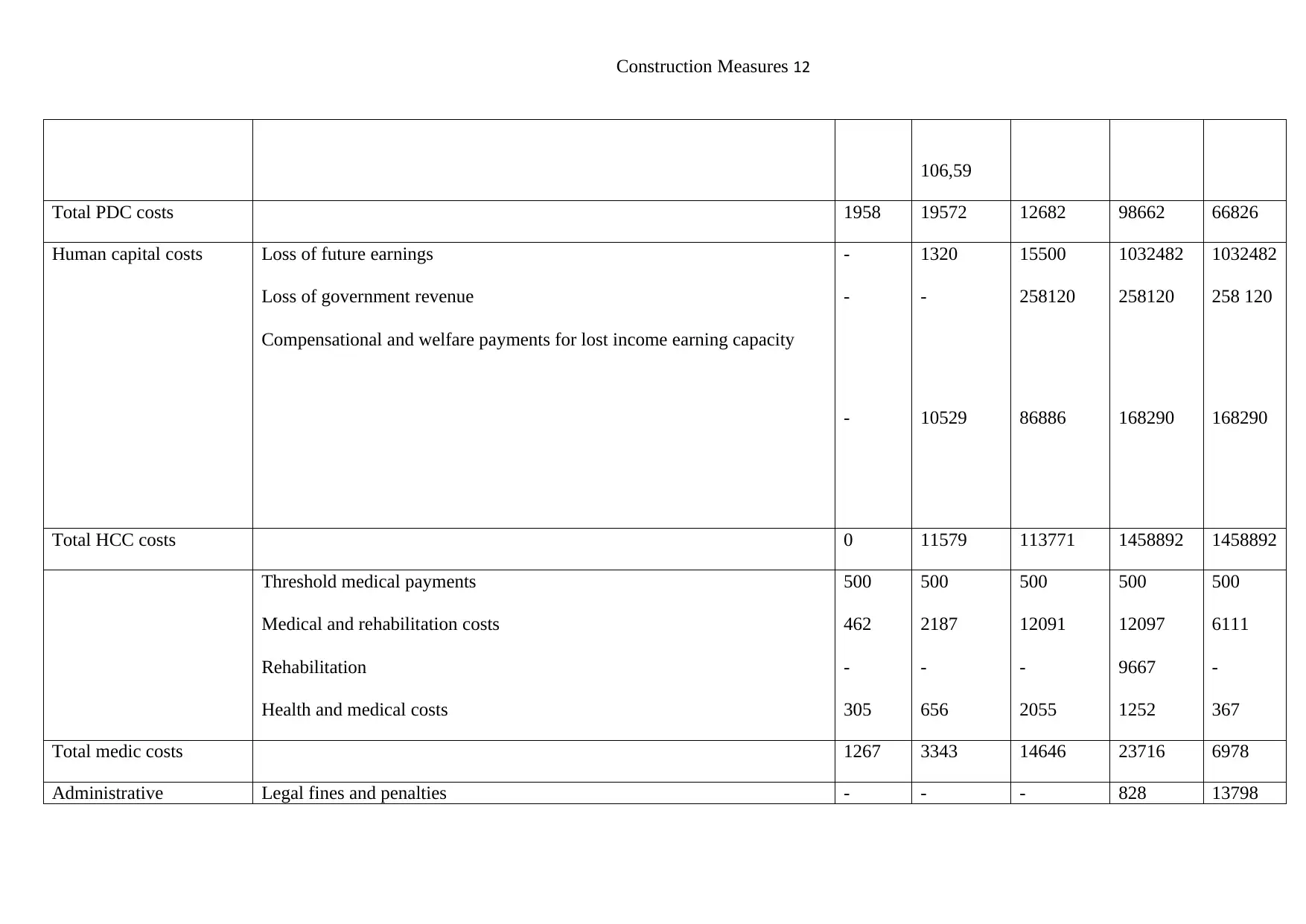
Construction Measures 12
106,59
Total PDC costs 1958 19572 12682 98662 66826
Human capital costs Loss of future earnings
Loss of government revenue
Compensational and welfare payments for lost income earning capacity
-
-
-
1320
-
10529
15500
258120
86886
1032482
258120
168290
1032482
258 120
168290
Total HCC costs 0 11579 113771 1458892 1458892
Threshold medical payments
Medical and rehabilitation costs
Rehabilitation
Health and medical costs
500
462
-
305
500
2187
-
656
500
12091
-
2055
500
12097
9667
1252
500
6111
-
367
Total medic costs 1267 3343 14646 23716 6978
Administrative Legal fines and penalties - - - 828 13798
106,59
Total PDC costs 1958 19572 12682 98662 66826
Human capital costs Loss of future earnings
Loss of government revenue
Compensational and welfare payments for lost income earning capacity
-
-
-
1320
-
10529
15500
258120
86886
1032482
258120
168290
1032482
258 120
168290
Total HCC costs 0 11579 113771 1458892 1458892
Threshold medical payments
Medical and rehabilitation costs
Rehabilitation
Health and medical costs
500
462
-
305
500
2187
-
656
500
12091
-
2055
500
12097
9667
1252
500
6111
-
367
Total medic costs 1267 3343 14646 23716 6978
Administrative Legal fines and penalties - - - 828 13798
⊘ This is a preview!⊘
Do you want full access?
Subscribe today to unlock all pages.

Trusted by 1+ million students worldwide
1 out of 18
Related Documents
Your All-in-One AI-Powered Toolkit for Academic Success.
+13062052269
info@desklib.com
Available 24*7 on WhatsApp / Email
![[object Object]](/_next/static/media/star-bottom.7253800d.svg)
Unlock your academic potential
Copyright © 2020–2025 A2Z Services. All Rights Reserved. Developed and managed by ZUCOL.





